Share your boat’s AIS info, easy with DataHub by PredictWind
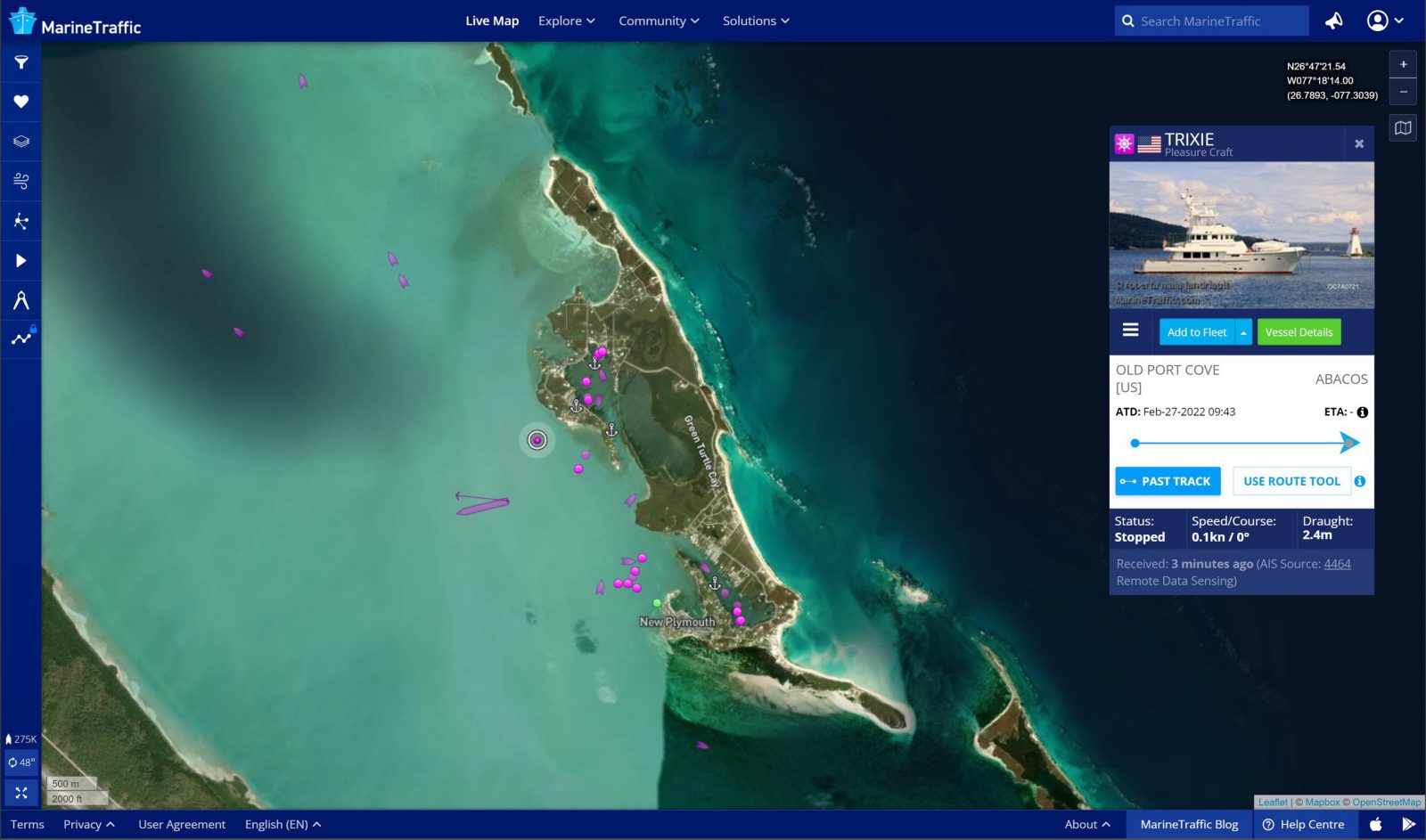
Do you use an AIS tracking website or app to follow cruising friends, check that your own AIS is transmitting, hunt for Russian oligarchs, and/or simply to identify an interesting vessel from your seaside restaurant table? Indeed, some of the services like Marine Traffic and FleetMon are now rich with photos, added vessel info, and features like extended track histories. But perhaps you’re also aware that volunteer receiving stations provide most of the data, and a lot more stations are needed to cover even just the planet’s coastal areas. So I’m pleased to report on a new, easy, and relatively inexpensive way to share the AIS info that may already be streaming around your boat.
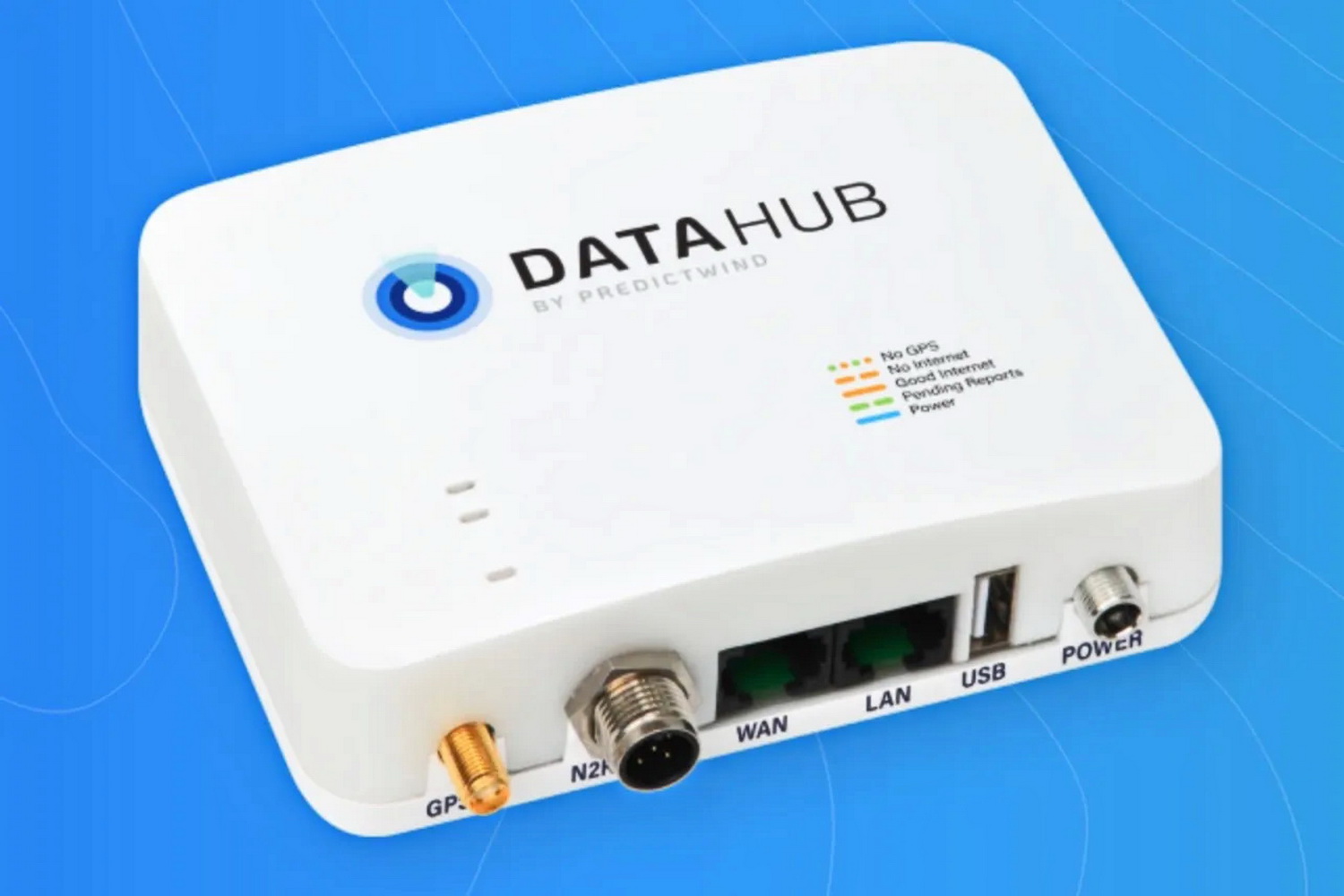

The recently introduced PredictWind DataHub is designed to do much more than share AIS info. In fact, this highly connected router supports all sorts of on- and off-boat features, some related to PredictWind’s well-known weather forecasting and vessel tracking/blogging services, some standalone. The possibilities are almost overwhelming at first glance, and I suggest two ways to research whether a $299 DataHub, and a possible PredictWind subscription, make sense for your boating:
- Check out the DataHub product page, particularly the well-done PDF Manual.
- Watch this SSCA DataHub webinar with live demos presented by lead developer Luis Soltero.
Note Panbo’s “Team Soltero” profile here and their PredictWind track/blog here. And, yes, while PW is mainly popular with cruising sailors, it can also make sense for a sea-going trawler like Bliss. But note too that no DataHub features require a PredictWind paid subscription except for tracking/blogging and the automated performance polar generation that’s still in development.
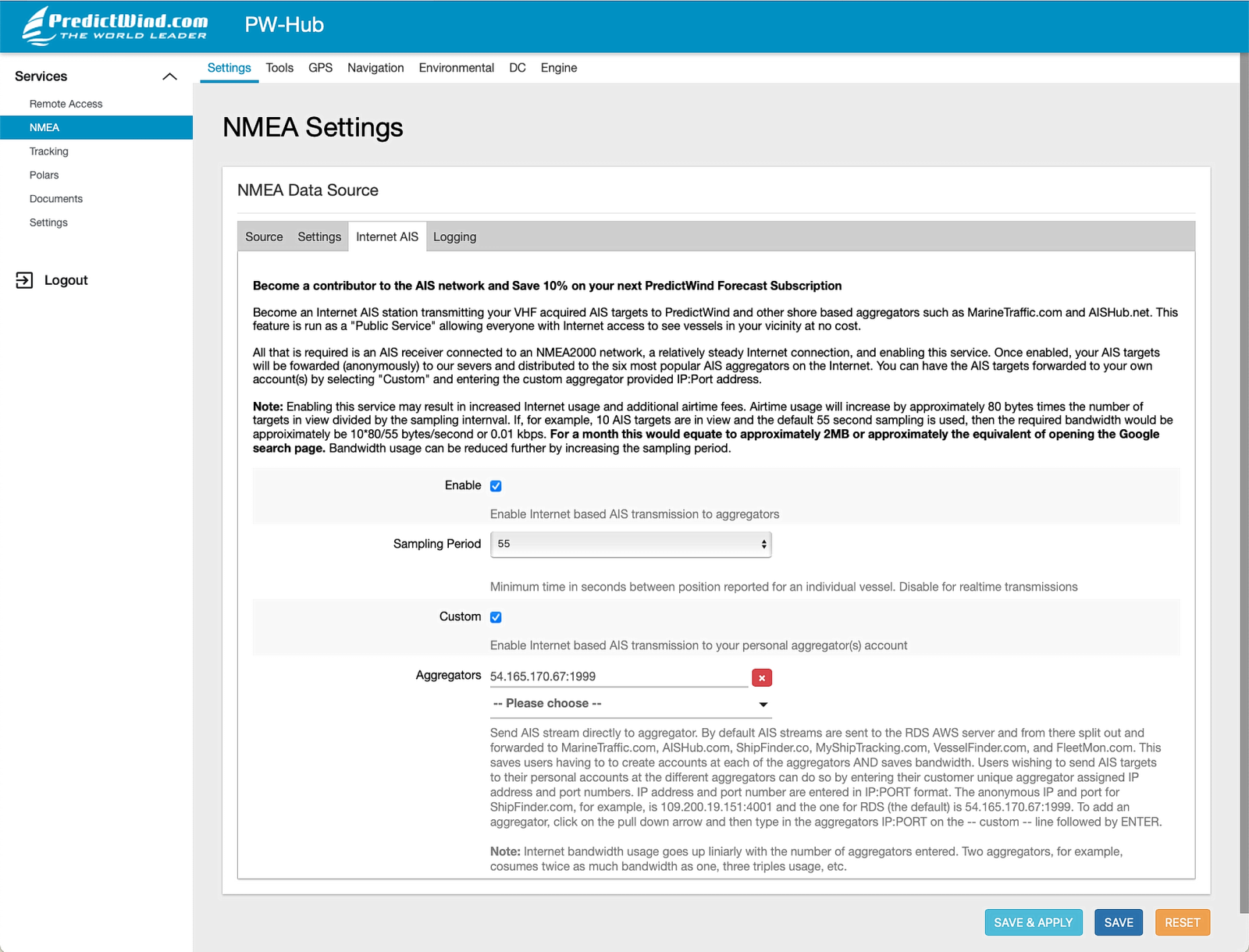
Now let’s focus on DataHub’s Internet AIS sharing, because it’s one of the slickest implementations I’ve seen. For instance, it takes just one click to Enable the default mode, and that mode efficiently sends downsampled AIS data via your boat’s WiFi, cellular, or satellite internet connection — which the DataHub can manage — to PredictWind’s own server where it’s then forwarded to six online AIS tracking services.
But because those services typically offer useful paid-subscription features to individually-registered volunteer receiving stations, DataHub supports that too, as seen in the Custom section above. You can even mix things up, perhaps registering for the perks with Marine Traffic — which currently seems to have the most complete global coverage — while letting PredictWind share your data with the other services. And note the “10% off your next PW subscription” bonus.
That’s all near perfection in my view. As the good folks at AISHub note, “There are many Web sites tracking AIS targets, and it’s amazing how much they vary in style, extra features, and even motivation.” To see this truth in action, check out the other sites that DataHub currently feeds: VesselFinder, ShipFinder, MyShipTracking, FleetMon, and MarineTraffic.
So I’m for sharing our AIS data with as many services as possible, to help them focus on developing their personalities with lots of data, rather than competing over exclusive sources. Moreover, I sometimes wonder if Marine Traffic has become overly dominant, the results being more ads cluttering free subscriptions, more features moving behind their paywall, and higher costs to get there.
This is also a “rich getting richer” situation, especially because most current shoreside volunteer stations use all-in-one AIS internet receivers that are designed to feed a single internet AIS service (like the Digital Yacht AISNET or the AMEC R150GE devices I’ve tested). And given how much better Marine Traffic’s coverage of my local Maine waters has gotten versus the other services, I too am guilty of abetting their domination (my long-running MT home station here).
But I did get MT to forward my feed to a few other services — though I don’t know if that’s still possible — and almost a decade ago I wrote about how free AISdispatcher software can feed multiple services at once when used with a regular AIS receiver and a PC, which is still true.
While the state of volunteer land stations is somewhat off-topic — and by the way, they tend to be expensive and somewhat fiddly to set up (unless you’re fairly IT literate) — it does highlight PW DataHub’s easy, flexible, and relatively inexpensive AIS sharing. Well, at least that’s true when your boat has a reasonable internet connection (and here comes StarLink).

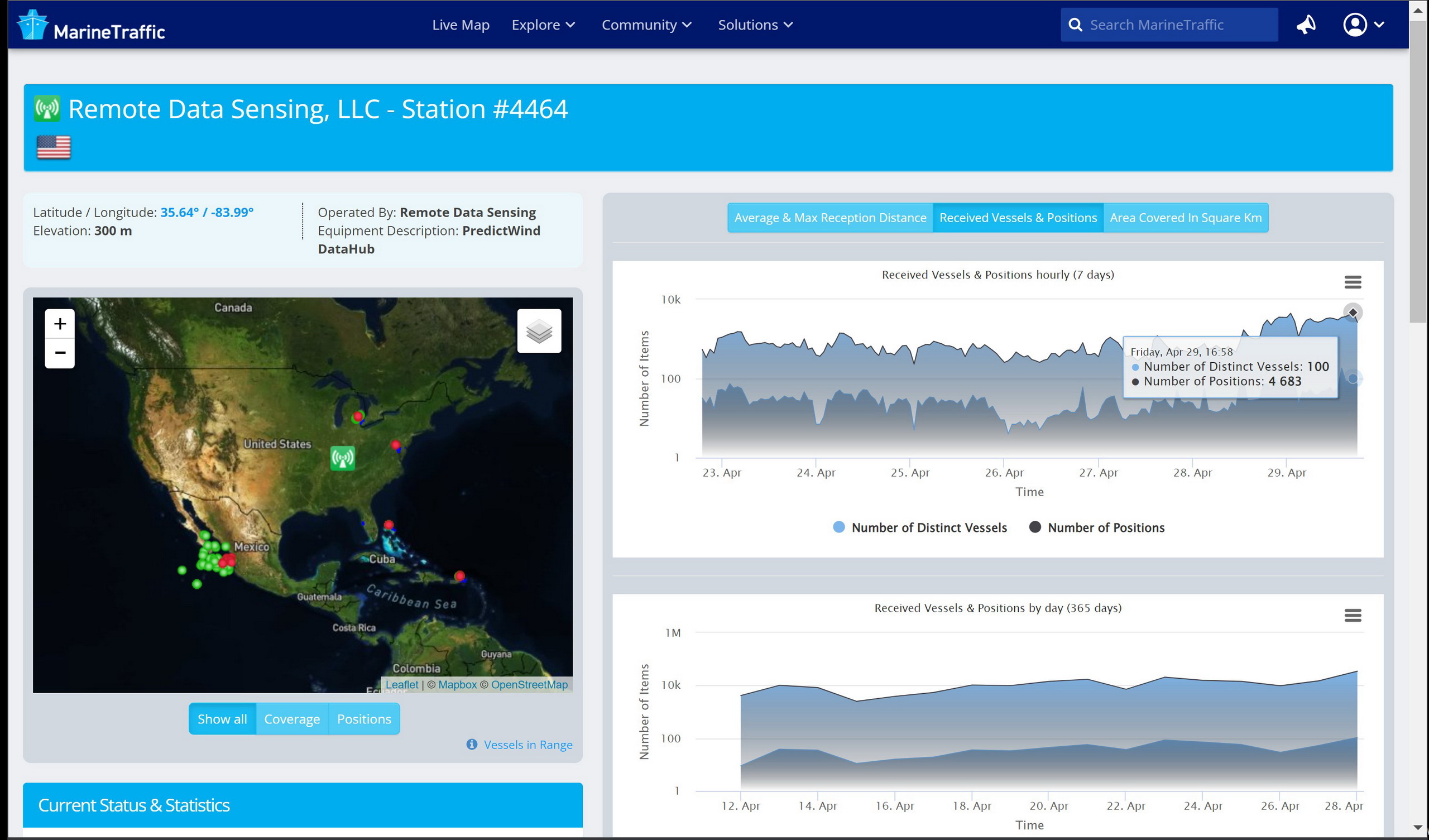
Also, despite only being online for a few weeks, the DataHub’s Internet AIS feature is working well. PredictWind’s aggregated AIS feed is called Remote Data Sensing, and several of the services share detailed performance statistics — specifically VesselFinder, MarineTraffic, and ShipFinder (again with different data presentation personalities).
So when I captured those screenshots last week, DataHub routers connected to boat NMEA data were delivering AIS info from Mexico, the Bahamas, the Chesapeake, Scotland, and New Zealand. In some cases, like the Green Turtle Cay screenshot at the top of this entry, none of those cruising vessels were being shared by any other volunteer receivers, even for Marine Traffic.
That’s one beauty of sharing AIS from boats, instead of from land. Mobile receiving stations get to places where shore stations are scarce or non-existent. And it’s definitely worth noting that the mobile tracking always includes your boat for the benefit of friends, family, and armchair cruisers… if you’re the volunteer and can stay online.
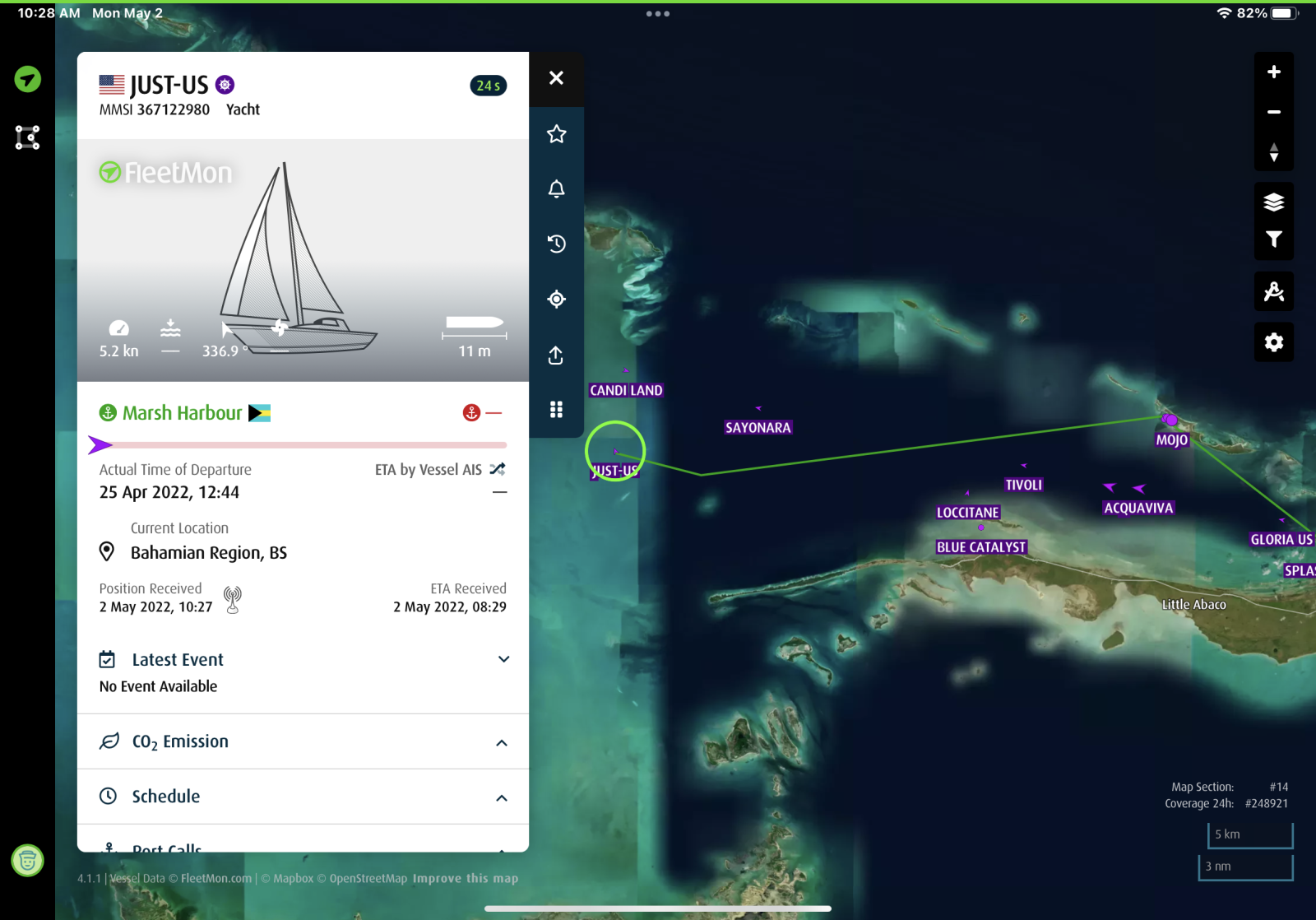
This screenshot from the FleetMon app shows many of the boats that were earlier around Green Turtle Cay passaging westward, including the DataHub-equipped volunteer station (which probably had a Bahamian cell connection). So Green Turtle is no longer well covered on internet AIS, but Cape Canaveral is, and that station will likely be improving coverage of the ICW and/or Southeast coast soon. Such is the nature of mobile stations, and why there should be lots of them.
This is a good point to note that the DataHub AIS sharing feature is quite like what FloatHub trailblazed in 2018, which let me reliably enjoy sharing Gizmo’s AIS for the several years (before the long layup). Moreover, FloatHub now has N2K hardware versions which will be easier to integrate with AIS transcievers in many cases, and will also improve their already stellar automatic trip logging and data widget features. (And Gizmo’s N2K test unit should be afloat and online soon, I’m happy to add.)
So FloatHub is a valid boat AIS sharing alternative, especially if monitoring is more the goal and you’re comfortable with their open source style. But FloatHub is a tiny company compared to PredictWind, which has many thousands of active subscribers around the world. And whereas the DataHub can make PW’s GPS tracking/blogging feature easier to use when, say, a related Iridium GO! is deactivated, it seems quite possible that their AIS internet sharing will increase rapidly.
Moreover, I learned during this research that PredictWind has AIS ambitions well beyond data sharing.
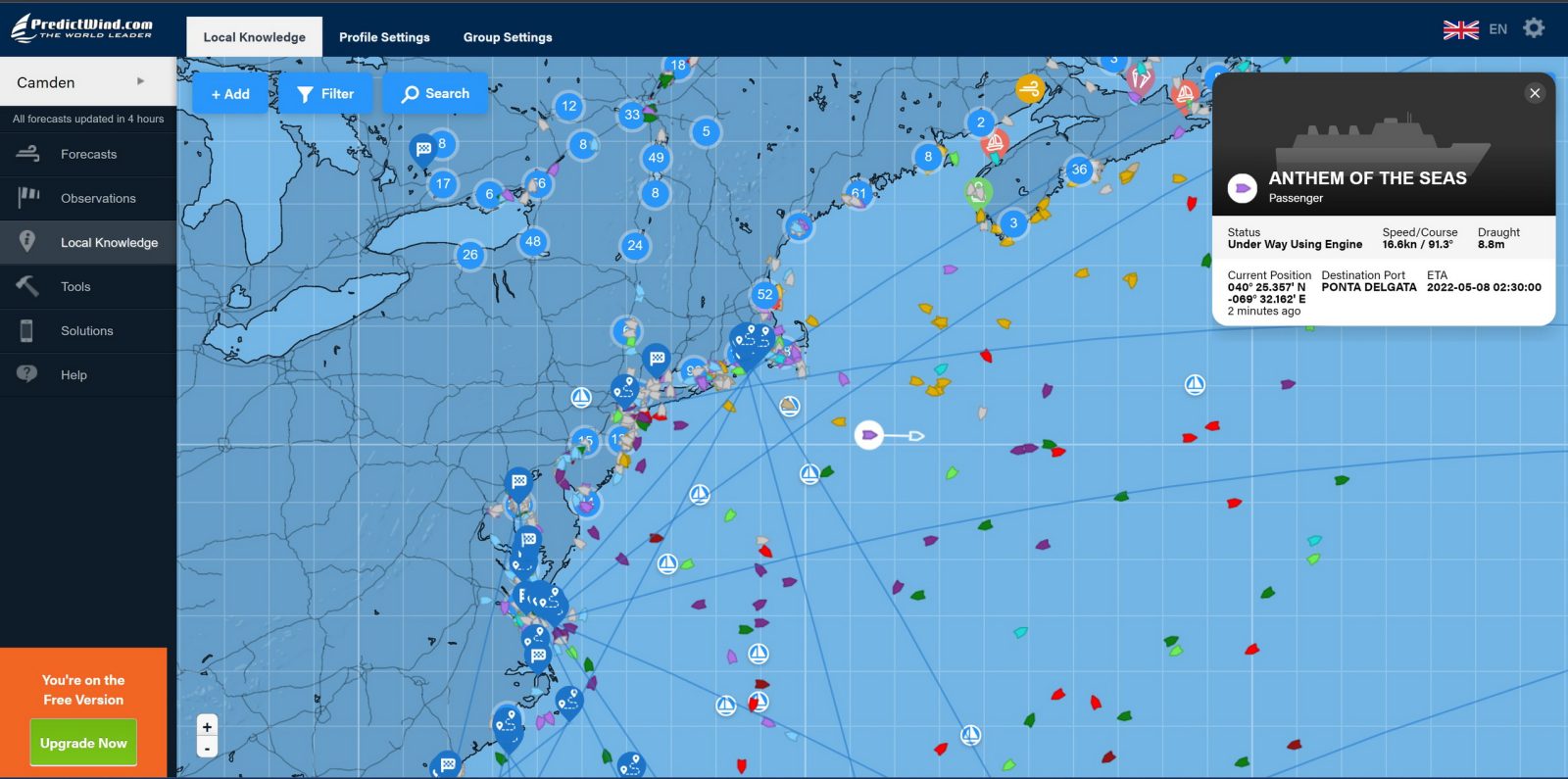
Last year PredictWind introduced Local Knowledge as a new section to their website and apps, and it’s already nicely loaded with user-submitted ocean routes, marina details, and much more. But at the end of that SSCA DataHub webinar, a PW representative discussed how they planned to add an AIS overlay and had even partnered with the satellite AIS data provider Spire to show ships at sea in near real time. And, by golly, a so-far-unannounced version of that service is now live at forecast.predictwind.com/local-knowledge, even to Free Version subscribers.
This pre-release of Local Knowledge with AIS is understandably a bit sluggish, but, heck, I’ve rarely seen undelayed satellite-sourced AIS detail at all, because typical internet AIS services require an enterprise level subscription. I gather that PW hopes to keep this data free or inexpensive, and also plans a subscription feature whereby boats with limited bandwidth can download the AIS targets within a 300 mile radius of their position. Wouldn’t a look at ships well beyond the normal AIS radiowave horizon improve situational awareness?
Satellites don’t receive low-power Class B AIS very well, but PW Local Knowledge will likely soon include AIS info from DataHub users (and maybe in trade with the other services receiving DataHub info). Note too that each of those white sailboat icons is the near realtime position of a PW subscriber, and a click will take you to their track possibly annotated with log notes and photos.
I’m impressed with what PredictWind is doing, and I haven’t even seriously tried the deep weather forecasting all this is built around. But I plan to, and also to keep an eye on the DataHub and Local Knowledge AIS iniatives. And hopefully some readers are now considering sharing their AIS?





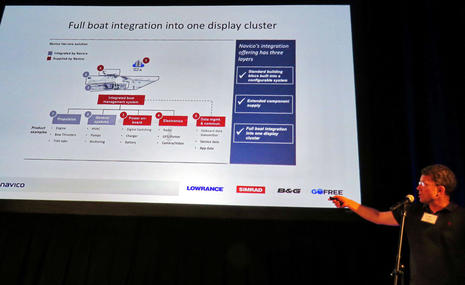






Good news from PredictWind regarding the Local Knowledge satellite AIS display:
“At present we use the SPIRE API directly to render the data, but soon we will download this data to our own database, and this will increase the performance by a huge factor!”
Aishub says:
“Your AIS feed will be added to our automatic monitoring and your data will be displayed at VesselFinder”
So they are already interconnected, no need to feed them both yes?
I think you’re right that AISHub and VesselFinder are closely connected, and AISHub also shares with some other services. But it’s all a bit murky behind the scenes, so maybe the more feeds the better.
Installed one just to get my N2K data feed on wifi. Not using the other features. Can say it is not ready for prime-time. As has been the case with most PW products. (And most tech products in general.)
Loses connection to computer, data filtering not very good. Interface is slow.
I admit, it is overkill for what I wanted but I thought a simple N2K>wifi interface would work easily out of the box.
I’ll add that I used it for 4 weeks on a crossing from Mexico to the Marquesas.
Can you make sure that you are running version 3.39 of the DataHub firmware? 3.39 adds the AIS sharing and also improves the N2K->N183 via wifi to include AIS targets.
You might take a look at the DataHub deep dive done for the SSCA… here is the link.
https://youtu.be/-0knWptRYB8
–Luis
I stopped using it. Not a solid piece of equipment. When I swapped it out for a nmea multiplexer / wifi bridge, my bad data problems went away (including wrong dates from GPS which I reported to Predictwind). Not ready for prime time when released.
my guess is that there is bad data on your N2K network which is resulting in the GPS data having bad data. We have seen this before… the PW for simplicity does not have a complex UI to make selections of which talker to listen to. it also doesn’t make any decisions on the data.. it converts what it sees and sends it on. your new name/wifi gateway might have some filtering intelligence in it that tosses out data that it deems incorrect.
My suggestion is that you enable NNEA logging on the hub and capture the log file. The log file is in antisense format so you can use the antisense ebl viewer to analyze the data. My guess is that you will find a GPS (possibly one that is older that has not been updated to deal with epoch change) that is putting invalid data on your N2K bus.
Wrong dates from GPS sounds almost 100% like a week rollover issue on some GPS unit, most likely Furuno.
I have currently 10+ discrete GNSS sources on my boat network. All the Furuno ones report wrong date, all the others – Garmins, Ublox, some OEM in android etc – do not.
If they are connected N2K, are they sampling wind information to share as live data with other boats or improve their forecasts? Capture location and depth information to resell to Navionics and others? Unlike most boats, With B&G I have accurate ground wind information, perhaps they should provide these receivers free if you sail often enough to make your data valuable.
Does it use SignalK? Surely Openplotter is the way forward.
Amen
A cursory look at the PDF manual and no reference to Starlink.
I would think PW would approach Starlink with an idea to include more boaters that have Starlink and not have to goto more expense with Iridium GO for AIS and other features not at all covered with a Basic subscription.
The small time user is just not important to PW.
When I’m logged into PW I see no offers or any doco on upgrading anything like what is shown in this blog post.
??
David, actually I’m pretty sure that a PW DataHub interface with Starlink is at the top of the development roadmap, and I’ll know more tomorrow as the chief developer Luis Soltero just arrived in my home harbor with a Starlink installed on his boat.
The sailboat/cruising community needs this sooner than l8r…
Hi David,
I am responding to this email using a Hub connected to starlink(SL). Starlink offers an always on internet connection either via WiFi or ethernet (if you have purchased the ethernet option). In essence starlink looks like any ordinary internet connection to the Hub.
You can WiFi tether to the starlink router or you can plug the starlink ethernet appliance into the WAN port of the Hub. Either method will get you onto the internet.
When using the WiFi bridge mode the only addition thing that needs to be done is to add a static route to 192.168.100.1 so that the SL app and the management portal (at http://192.168.100.1) are available. This can be done using the super admin login and its pretty straight forward.
I have actually converted my SL to DC power using a 12-48 DC-DC converter and a PoE injector purchased all on amazon. This does two things.. I reduces the power consumed by SL by 50% and provides an ethernet interface to the satellite system. In my setup I have SL connected to the WAN port of the HUB and an inexpensive android phone with a Visible.com SIM card connected to the USB port. The HUB routes traffic preferentially to starlink if it has internet connectivity and in areas where there is no SL connectivity the HUB automatically routes traffic through the cell phone.
All has been working flawlessly for about 4 weeks now. BTW.. in my new setup there is no need to add a static route to 192.168.100.1 since dishy manages the DHCP and the IP address assigned to the HUB on the WAN port is in the 192.168.100.X subnet.
So… yes.. HUB supports starlink without issue.
BTW… to use the HUB AIS services listed in this article you may need to update the firmware to version 3.39… PW supplies instructions for this. Once done then you will see the 10% off in the AIS section. Basically, PW offers 10% off the subscription service to anyone who shares their AIS.
send an email to [email protected] should you have any questions.
–Luis
Hello, Luis, I’m trying to do exactly what you’re describing. I’ve converted my dishy to run of DC, and it works fine off the Starlink Router, but plugging into DataHub I get no love. Sometimes it gets a DHCP address, but it just flaps up/down over and over. You’ve got me thinking that I may have a wiring issue or something else. You’re the first person I’ve found on the internet that has this working. Thank you for posting your about setup.
Hi Redwood,
hm…interesting… I ran this way all summer. What conversion instructions did you use?
Here are the instructions I used.
https://www.dropbox.com/s/xbboqaxq3oggpm1/Starlink%2012%20or%20120%20volt%20and%20WiFi%20Router%20Delete%20-%20Ver%202-1.pdf?dl=0
On a side note… I looks like ART in Miami is going to commercialize this and come out with a ready made product to do this.
So… I take it you are not using the StarLink router at all?
Anyway… I ran my 24/7 for 3 months without issue. No special setup on the Hub… just plugged the ethernet cable into WAN port.
BTW… the power consumption with this setup is about 2 amps… about 50% less than using the stock SL router.
–Luis
Hi! Thanks for the reply. Same instructions for the most part, with the majority of the details being 99% the same. I can run with the Starlink router using a coupler, no problems. So I’m pretty sure I’ve eliminated the POE injector, the wiring, the boost converter.
Yeah, the power usage is our main concern here, smaller boat. And well, we want to use the DataHub anyway.
I believe I’m suffering from the DHCP Lease outlined here: https://nelsonslog.wordpress.com/2021/04/07/openwrt-vs-starlink-dhcp-leases/
One blog post I’ve read suggests that I need to power off the Starlink Router for an hour or more to let DHCP leases expire back at the Starlink homebase. I can’t quite wrap my head around this, but I’m going to give it a try.
Unfortunately I am not on the boat but I don’t remember having DHCP issues. Could be that issues started up after I left the boat with a firmware update to starlink.
Have you tried assigning a static IP address to the interface. This is easily done on the hub by logging in a super admin and then navigating to Network->Interfaces. Edit the WAN interface and give it a static IP address in the subnet that SL is expecting.
This from the OpenWRT post above
I finally just clicked the “reset” button next to the WAN port in the OpenWRT UI; that caused it to fully reset the link and get a new working address via DHCP. And all is well.
You can do this from super admin account…. Once you get an IP address that works I suggest changing the WAN config to static using that IP address or an address in the same subnet.
Let me know if that works.
Luis, thank you so much for all your help. I was able to finally troubleshoot this issue to the power supply.
Even though I installed a high quality power supply, it’s not powerful enough to get all the way through the boot cycle, so Dishy would come up, issue the temporary DHCP address and at some point the power supply would reset because of over current protection, and the Dishy would, obviously, reboot. An amp meter and volt meter and close monitoring of the power supply for two minutes after initial boot finally uncovered the problem.
Hopefully this helps others out there. Look for a power supply providing close to 400 watts as you can find.
Data Hub now is able to generate class B VDO messages for transmission to the AIS aggregators without the need to have an AIS receiver or transmitter. This allows users without AIS to be tracked on MarineTraffic and other tracking websites without the need of any additional hardware. All that is required is a Hub and an Internet connection.
AIS messages are stored on the SD car when there is no internet and then uploaded to Aggregators that accept historic positions when the internet is available.
–Luis
Interesting! PredictWind is offering existing customers early access to the new Exec model Iridium GO said to be 40x faster than the original model. There’s not much info online yet, but here are some tastes of what’s coming:
https://youtu.be/XvUpqlQP0-E
https://satellite.predictwind.com/limited-launch-shop
Also, the DataHub will get new features apparently designed to integrate well with the new GO! exec will enable several new DataHub features like the PredictMail already in beta:
https://www.predictwind.com/predictmail/
With some really good algorithms to account for tide, heel, and installation differences between boats, and I think they could crowdsource better depth contours and shifting bottoms for our MFD’s.